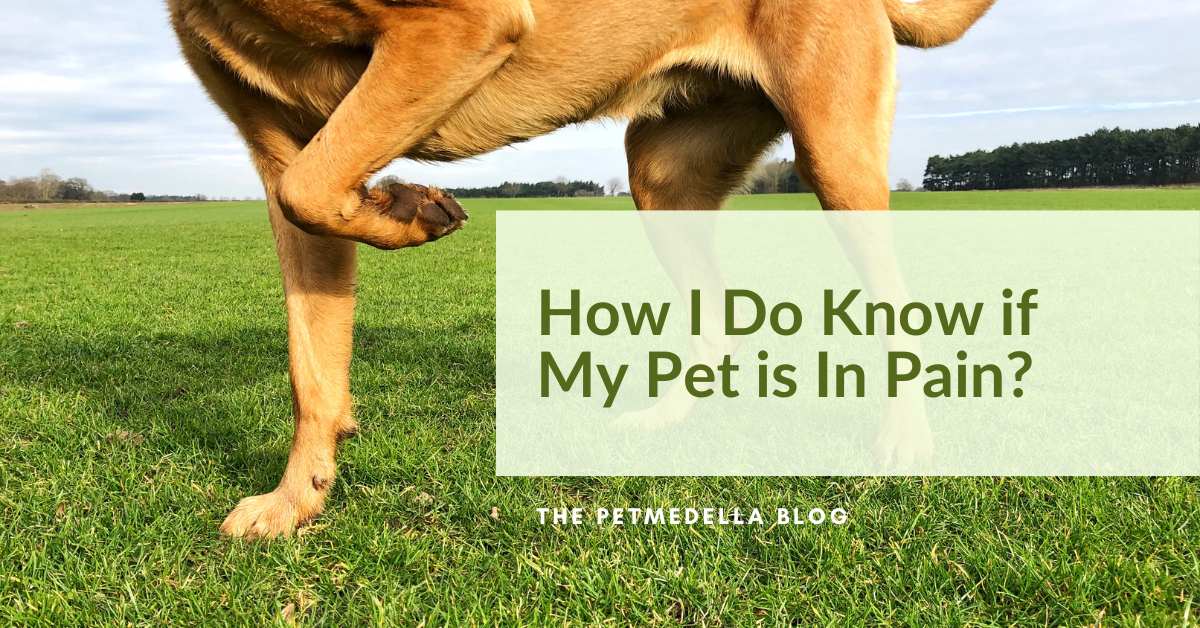
Pet’s communicate in many ways, except human words. How do you know if your pet is in pain?
We wish they could talk, don’t we? We can communicate with animals on so many levels, but the expression of pain in our pets does not come out in the form of words that we can share. September holds a special place in the hearts of pet owners and animal wellness professionals.
September is Animal Pain Awareness Month, a time to spotlight the importance of recognizing and managing pain in our furry friends. As pet owners, we need to be vigilant about our pets’ well-being and respond promptly to any signs of discomfort. This blog post will help you understand how to know if your pet is in pain, and explore natural remedies for pain relief at home.
As always, please visit a licensed veterinary professional if your pet has had an injury or if you wonder if your pet is in pain. If your pet seems to be in pain, please take it for veterinary attention!
There are four types of pain, acute, chronic, cancer, and neuropathic (1). Acute pain is related to a recent injury or illness, whereas chronic pain is long standing. Cancer pain is self explanatory, and may have both acute and chronic pain, from the disease itself, or treatment. Nerve damage is what may cause neuropathic pain. This is a hard type of pain to detect. If looking at a bioresonance PetMedella report for your pet, this may show up as the Central and Peripheral Nervous System.
Sometimes pain that is acute, like a dental infection, can become chronic and long standing if not taken care of.
How do you know if your pet is in pain? The Art of Observation
Pets, especially cats and dogs, are experts at hiding their discomfort. Their instinctual behavior to mask their pain can make it challenging for pet owners to detect any health issues, including pain. If you want to know if your pet is in pain, your answer may come with observation.
By observing subtle alterations in their everyday activities, you can discern how to know if your pet is in pain.
Changes in Daily Habits
Pets are creatures of routine. They enjoy, and expect, the same schedules day in and day out. Therefore, any deviation from their normal behavior might indicate discomfort. This could include changes in their grooming, sleeping, eating patterns, or even unusual aggression. If your pet is hesitant to go on their routine walk, or climb their favorite cat tree, this could be a sign of pain, or other health issues.
Physical Signs and Symptoms
Apart from behavioral changes, physical symptoms such as restlessness, rapid breathing, tail flicking, or difficulty in jumping can also indicate that your pet is in pain. Additionally, vocalization like excessive meowing, growling, or hissing in cats or whimpering and yelping in dogs could be a way to recognize how to know if your pet is in pain.
What about excessive licking? We see lots of complaints about licking from pet parents, with the assumption that the pet has a skin, or Integumentary System issue. According to the petcare website PetMD, excessive licking may be because of pain.
Changes in Body Posture
Another crucial sign to pay attention to is your pet’s body posture. A hunched back, limping, or reluctance to move might suggest that they are in pain. If your pet avoids being petted or handled, it could be an indication of physical discomfort.
Natural Home Remedies for Pain Relief
If your pet appears to be in pain, please consult a vet to diagnose the cause and initiate a suitable treatment plan. Once the vet has determined the cause of pain, you can explore these natural remedies below, in conjunction with your vet’s treatment protocol, to ease your pet’s discomfort at home.
A Remedy Scan would be the perfect solution to support any ongoing pain issues for your pet! We have every client fill out a Health Questionnaire, listing all medications, to make sure the remedies that balance do not conflict with medications!
Flower Remedies
Pain can significantly heighten stress levels in your pet. How would you see this on a scan? Many times the hypothalamus, pituitary & pineal glands, along with the adrenals, and even thyroid show up on a report. You may see a stressed Nervous System, Endocrine System, or even Digestive System.
Many pet owners try pheromones to alleviate this stress, thus indirectly reducing their pain. Synthetic pheromones mimic the natural ones cats release through their facial glands to mark their territory and make them feel secure. Flower essences are another fantastic, natural and safe way to decrease the stress in the Nervous System and the Endocrine System, so your pet’s pain response is lessened.
You can purchase a single essence or a blend. Our most popular item is Ultimate Rescue, and a close second is Ultimate Fields. These two blends resonate with the hair and saliva samples of pets who have separation anxiety, are genetically more anxious, or rescued pets who have suffered with neglect.
Turmeric
With its powerful anti-inflammatory properties, turmeric can relieve joint pain associated with age-related conditions like arthritis. The primary active ingredient in turmeric, curcumin, is known for its anti-fungal, antibacterial, anticoagulant, antiseptic, astringent, and wound healing properties. It also works to fight free radicals.
You can add a small amount of turmeric mixed with a healthy fat, like fish oil or coconut oil, to your pet’s food. Purchasing turmeric in a tincture provides an increase in chemical constituents of the root. Tinctures are an easy way to give herbal remedies to pets. Just drop in hot water and let cool to dissipate the alcohol!
Cold and Heat Therapy
For recent injuries, cold therapy can numb the area, reducing swelling, redness, and pain. Cold packs and cold therapy works on the circulatory system, which delivers increased blood flow to an injured area, so immune cells can also do their work against invaders. When this happens, you may see swelling, and this also brings about a pain response, as this is related to nerves, and the nervous system.
However, for long-term injuries or chronic pain, heat therapy can relax your pet’s muscles and increase blood flow to the affected area. This increased vascularity allows healing of the body by bringing increased oxygenation and nutrients to the area.
Omega-3 Fatty Acids
Omega-3 fatty acid supplements can help reduce inflammation related to arthritis, allergies, kidney disease, and more. The primary active ingredients, EPA (eicosatetraenoic acid) and DHA (docosahexaenoic acid), can control inflammation in your pet’s body. Our Full Scan looks for resonating imbalances in these Essential Fatty Acids:
- ALA (Alpha Linoleic Acid)
- EPA (eicosatetraenoic acid)
- DHA (docosahexaenoic acid)
- GLA (Gamma Linoleic acid)
- CLA (Conjugated Linoleic Acid)
Fatty acids build cell membranes, affect enzymes, help in cognition in mammals, and provide metabolic energy. They also support the function of receptor sites on a cell, where hormones try to fit, to signal a cell (2). Some toxins compete for receptor sites on cell membranes, so a good supply of fatty acids are needed.
Diet Modification
Obesity can put indirectly additional pressure on your pet’s joints, leading to pain and health issues later in life. Consult with your pet’s health practitioner to determine an ideal weight for your pet and develop a nutritional plan to achieve that goal. Using natural remedies, while attending to your pets balanced caloric intake, can ease discomfort while you work on a healthier diet. Probiotics and BioCell Salts are two options that are foundational for overall pet health.
New to BioCell Salts, other wise known as tissue salts? Jump here after this post!
Glucosamine and Chondroitin Supplements
Glucosamine and chondroitin are naturally occurring substances in your pet’s body that help repair and protect their joints. By adding these supplements to your pet’s diet, you can help lubricate their joints, reducing friction and preventing cartilage breakdown. You can also make a Simple Bone Broth for your pet as well!
This adds minerals and collagen, which supports the Joints, within the Locomotor System as well.

Why NSAIDs Are Not Recommended for Pets
While it might be tempting to give your pet an over-the-counter pain reliever, many common non-steroidal anti-inflammatories (NSAIDs), as well as acetaminophen, can be extremely harmful to your pet. Cats are notably more sensitive to NSAIDs than dogs, putting them at risk of side effects like ulcers, blood clotting, and kidney damage. Therefore, it’s best to avoid giving your pet any over-the-counter pain relievers without consulting with your vet first.
Choosing the Right Remedy for Your Pet
Every pet is unique, and the appropriate remedy for their pain will depend on their specific needs and health situation. By combining veterinary advice with these natural remedies, you can help your pet navigate through their discomfort and enjoy a pain-free life.
Wonder how to know if your pet is in pain, and curious which Remedy would fit with your pet? It’s hard to decide between so many herbal remedies, homeopathics, and nutritional supplements.
Our Remedy Scan takes the guesswork out of choosing natural pain remedies for your pet!
Sources:
https://www.merckvetmanual.com/special-pet-topics/pain-management/types-of-pain
https://www.intechopen.com/chapters/63324
*This post about how to know if your pet is in pain is for educational purposes only and not intended as medical advice. Please seek help from your licensed practitioner if you suspect a health problem or condition.
